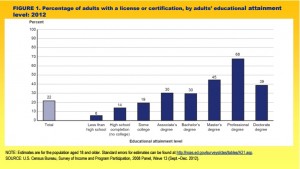The Potential of Career Pathways
Two new reports explores the history and potential of career pathways.
First, a new report from the Office of Career, Technical, and Adult Education (OCTAE) examines the evolution of career pathways over the past 30 years as the country has adapted and responded to the need for a skilled workforce. Further, it also offers strategies for state and local stakeholders to consider when developing a comprehensive pathways system that connects and aligns education and workforce development systems.
The paper, published as part of OCTAE’s three-year initiative to advance CTE in state and local career pathways, cited the 2014 passage of the Workforce Innovation and Opportunity Act and the Administration’s Ready to Work initiative as “game-changing†actions that will continue to drive cross-systems alignment.
“When looking at what has worked in career-related education and training programs historically, it becomes clear that a comprehensive Career Pathways systems approach holds significant promise for providing Americans with the skills and credentials needed for high-demand jobs and careers,†the report states.
The report was produced by Jobs for the Future, which is contracted by OCTAE to manage the career pathways project.
Meanwhile, from the Brookings Institute, economics expert Harry Holzer calls for expanding high-quality CTE – including career pathways and work-based learning, to help the nation better meet the needs of employers’ skill demands. Specifically, Holzer writes that community colleges and employers need better incentives to invest in middle-skill workers and adapt as the labor market changes. He offers three solutions:
- Provide more resources to community colleges and smaller four-year institutions while also creating incentives and accountability through performance-based funding;
- Expand high-quality CTE and work-based learning such as apprenticeships; and
- Incentivize employers to create more good jobs, as well as other supportive policies including higher minimum wages.
What Happens When Students Transfer
A new study examines what happens when students transfer from and to four-year institutions.
From the Community College Research Center, “What We Know about Transfer,†takes a look at student transfer patterns, outcomes, barriers and the economic benefits of transferring in a new brief, and call transferring a “vital route to a bachelor’s degree for many underserved students.†Yet, the authors caution that policymakers should pay keen attention to the transfer process to protect the credits students have earned in order to create an efficient, seamless process for college attainment.
Data, Data, Data
The National Center for Education Statistics (NCES) released a new brief in its “Data Point†series that looks at the  relationship between education and work credentials. Analyzing the U.S. Census Bureau’s Survey of Income and Program Participation, NCES found that more than one in five adults, nearly a quarter, have a work credential. Of these, 71 percent have a license and 29 percent have a certification. Also, more than half of those holding a work credential have less than a bachelor’s degree.
relationship between education and work credentials. Analyzing the U.S. Census Bureau’s Survey of Income and Program Participation, NCES found that more than one in five adults, nearly a quarter, have a work credential. Of these, 71 percent have a license and 29 percent have a certification. Also, more than half of those holding a work credential have less than a bachelor’s degree.
NCES also released two new data sets of note:
- An update to its High School Longitudinal Study, which includes a look at CTE coursetaking
- Trends in high school dropout and completion rates from 1972-2012
Andrea Zimmermann, State Policy Associate

